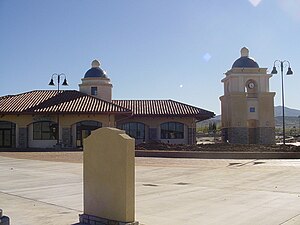Antelope Valley Line
| Antelope Valley Line | |||
|---|---|---|---|

|
|||
| Overview | |||
| Type | Commuter rail | ||
| System | Metrolink | ||
| Status | Operating | ||
| Locale | Northern Greater Los Angeles Area | ||
| Termini |
Los Angeles Union Station Lancaster |
||
| Stations | 11 | ||
| Daily ridership | 6,036 (Q3 2013) | ||
| Operation | |||
| Opened | October 26, 1992 | ||
| Owner | Metrolink (track; Los Angeles-Downtown Burbank), Union Pacific (track; Downtown Burbank-Lancaster) | ||
| Operator(s) | Metrolink | ||
| Character | Mostly surface-level with one underground section. | ||
| Technical | |||
| Line length | 76.6 miles (123.3 km) | ||
| Track gauge | 4 ft 8 1⁄2 in (1,435 mm) | ||
| Operating speed | 79 mph (127 km/h) maximum 37 mph (60 km/h) average |
||
|
|||
The Antelope Valley Line is a commuter rail line that serves the Northern Los Angeles County area as part of the Metrolink system. The line is rural in character because it travels through the sparsely populated Soledad Canyon between Santa Clarita and Palmdale, serving the small community of Acton along the way. Other portions of its route parallel the former US Route 6, now San Fernando Road and Sierra Highway.
The line began service on October 26, 1992, and was called the Santa Clarita Line at the time. It was one of three original lines in the Metrolink system along with Ventura County and San Bernardino lines.
The route initially ran from Los Angeles Union Station in Downtown Los Angeles to the Santa Clarita station making stops only at Glendale and Downtown Burbank stations.
Since the beginning of service, Metrolink had plans to extend the line north to the Antelope Valley but these plans were expedited by almost 10 years following the 1994 Northridge earthquake. The earthquake caused the collapse of the freeway connector of State Route 14 (the Antelope Valley Freeway) onto Interstate 5 (the Golden State Freeway) at the Newhall Pass interchange, forcing all traffic to use the parallel 2 lane truck bypass that was unaffected by the quake. With funding from the Federal Emergency Management Agency the Southern California Regional Rail Authority constructed an emergency extension of the line to Lancaster to help relieve the traffic bottleneck. The U.S. Navy Seabees construction battalion and crews from the L.A. County Public Works Department were able to construct the stations in just a few days, compared to the normal three to six months. Emergency stations in Lancaster and Palmdale were both built in just three days and Metrolink started operating trains one week after the earthquake struck. Over the next five weeks additional emergency stations were added in Sylmar/San Fernando, Vincent Grade/Acton and Santa Clarita (Via Princessa). While most of the emergency stations have since been replaced with permanent stations, the Via Princessa station still uses the same platform built after the earthquake.
...
Wikipedia
